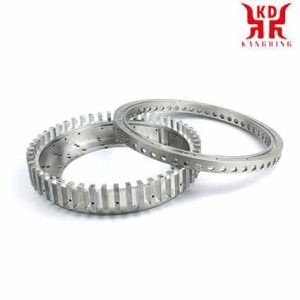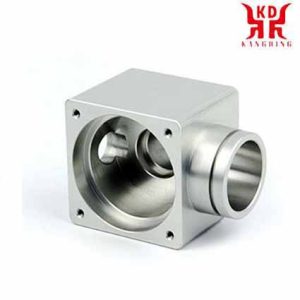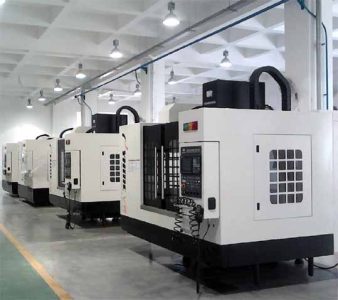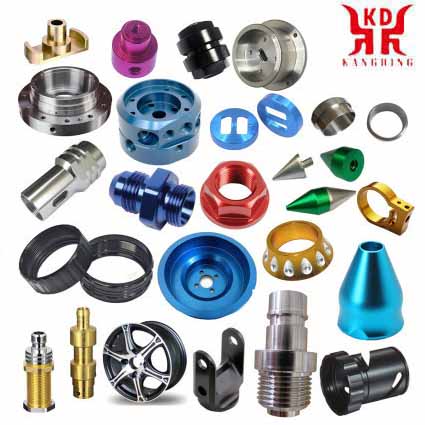Čo je frézovanie? Aký je proces frézovania? Aké diely je možné obrábať CNC frézovaním? Akú presnosť môžu čínske frézovacie diely dosiahnuť?

Čo je frézovanie?
CNC frézované diely
Ako sa vyrábajú CNC frézované diely?
CNC frézované diely sú obrábané na CNC frézach pomocou rotačných nástrojov. Používajú sa CNC frézky s rôznym stupňom voľnosti pohybu: 3-os, 4-osové a 5-osové frézky.
3-axis milling machines can only machine CNC milled parts from one accessibility direction. They are cheaper than the other types of milling machines. 4-axis milling machines have an additional axis of rotation for the milled part, for example for the production of spindles and other helical geometries. 5-axis milling machines can machine CNC milled parts from all sides, depending on the clamping, and also produce complex geometries.
With our supplier network, we can manufacture a wide range of CNC milled parts for a wide variety of requirements.
We specialize in CNC machining, our automatic price calculation is constantly being expanded and currently covers components with the following properties.
Milling consists mainly of cutting the material that is machined with a rotary tool with several edges, called teeth, lips or carbide inserts, which executes programmed advance movements of the worktable in almost any direction of the three Possible axes on which the table where the part to be machined is fixed can be moved.
With the increasing use of numerical control milling machines, the milling operations that can be carried out with this type of machine are increasing, and thus milling has become a multipurpose machining method. The development of the tools has also contributed to create new possibilities of milling in addition to considerably increasing the productivity, quality and accuracy of the operations carried out.
| Our manufacturing options for CNC milled parts
Component dimensions from 2 mm x 2 mm x 2 mm |

cnc frézovacie diely
Frézovacie nástroje
Frézovacie nástroje sa vyznačujú vonkajším priemerom, počet zubov, rozstup zubov (chápaná ako vzdialenosť medzi dvoma po sebe idúcimi zubami) a upevňovací systém frézy na stroji.
Druhy frézovania
Na univerzálnych frézkach s použitím vhodného príslušenstva alebo na číslicovo riadených frézkach je možné vykonať nasledujúce plánovanie.
Najčastejšou aplikáciou frézovania je čelné frézovanie, ktorého cieľom je dosiahnuť rovné povrchy. For the face milling milling cutters with interchangeable carbide inserts are generally used, there is a very varied range of diameters of these mills and the number of inserts that each milling cutter mounts. Insert manufacturers recommend as a first option the use of round inserts or with 45º angles as an alternative.
Square milling. Square milling is a variant of face milling that consists of leaving perpendicular steps in the part to be machined. Pre to, square inserts are used that are located in the tool holder in an appropriate way.
Cube Milling. The cubing operation is very common in vertical or horizontal milling machines and consists of preparing the metal dowels or other material such as marble or granite in the appropriate cubic dimensions for subsequent operations. Toto frézovanie sa vykonáva aj s vymeniteľnými doštičkovými čelnými frézami.

cnc frézovacie diely Druhy frézovania
Rezané frézovanie. Jedna z počiatočných operácií obrábania, ktorá sa musí vykonať, často pozostáva z rezania kusov na určenú dĺžku, počnúc komerčnými tyčami a profilmi väčšej dĺžky.. Pásové píly alebo frézy vybavené valcovými frézami sa používajú zameniteľne na priemyselné rezanie dielov. Na rezných frézach je dôležité, že môžu byť vyrobené z rýchloreznej ocele alebo tvrdokovu. Vyznačujú sa tým, že sú veľmi tenké (na objednávku 3 mm, aj keď sa môže líšiť), s veľkým priemerom a veľmi jemnými zubami. Príklad charakteristík frézy by bol nasledujúci: priemer 200 mm, hrúbka 3 mm, priemer otvoru z 32 mm a 128 zuby: Dobre 128, Hrubý 64.
Priame frézovanie drážok. For milling straight grooves, cylindrical cutters with the width of the groove are generally used and often, to increase production, several cutters are mounted on the cutter shaft allowing to increase machining productivity. The assembly of several cylindrical strawberries is called a train of strawberries or compound strawberries. Cylindrical burs are characterized by having three cutting edges: the front and the two sides. High speed steel burs are used in most applications since carbide burs are very expensive and are therefore only used in very large productions.

cnc frézovacie diely Druhy frézovania
Shape grooving.. Burs of the appropriate shape for the groove are used, which can be T-shaped, dovetail, atď.
Keyway grooving. Cylindrical strawberries with handles, known in slang as ballerinas, are used that can cut both in a direction perpendicular to its axis and parallel to it.
Milling in Copying. Round insert profile cutters are used for copy milling in order to be able to carry out machining operations in orographies and profiles of changing faces. There are two types of copy cutters: those with a half ball profile and those with a round or toric edge.
Frézovanie dutín. In this type of operation, it is advisable to carry out a prior drilling and from there and with suitable milling cutters, approach the cavity machining, bearing in mind that the radii of the cavity must be at least 15% greater than the radius of the milling cutter.
Lathe-milling. Tento typ obrábania využíva kruhovú interpoláciu v numericky riadených frézach a používa sa na presné sústruženie otvorov aj vonkajšie sústruženie. Proces kombinuje rotáciu obrobku a frézovacieho nástroja, čo umožňuje dosiahnuť valcový povrch. Tento povrch môže byť sústredný vzhľadom na stredovú líniu otáčania dielu, alebo môže byť excentrický, ak sa frézovanie pohybuje nahor alebo nadol. Axiálnym posunom je možné dosiahnuť požadovanú dĺžku.
Frézovanie závitov. Frézovanie závitov vyžaduje frézku schopnú simultánnej špirálovej interpolácie v dvoch stupňoch voľnosti: rotácia dielu vzhľadom na os skrutkovice závitu a posunutie dielu v smere uvedenej osi.
Čelné frézovanie. Pozostáva z frézovania, ktoré sa vykonáva s valcovými skrutkovitými frézami, ktoré napadajú frézovaciu operáciu spredu. Čoraz viac plne integrálnych tvrdokovových fréz sa používa v numericky riadených frézach, ktoré umožňujú prácu pri veľmi vysokých rýchlostiach.
Frézovanie ozubených kolies. Frézovanie ozubenia sa na univerzálnych frézach s deliacou doskou už takmer nevykonáva, ale vykonáva sa na špeciálnych strojoch nazývaných odvaľovacie stroje na ozubenie a s použitím špeciálnych fréz príslušného zubového modulu.
Vŕtanie, vystružovanie a nudné. Tieto operácie sa zvyčajne vykonávajú na číslicovo riadených frézach vybavených zásobníkom nástrojov a s použitím vhodných nástrojov pre každý prípad.
Dlabanie. Pozostáva z opracovania klinových drážok v otvoroch, pre ktoré sa používajú preťahovacie stroje alebo špeciálne príslušenstvo, ktoré je pripevnené k hlave univerzálnej frézky a transformuje rotačný pohyb na alternatívny vertikálny pohyb.
Rampové frézovanie. Ide o bežný typ frézovania pri obrábaní foriem, ktoré sa vykonáva buď pomocou kopírovacích fréz alebo fréz s číslicovým riadením..
Ako funguje CNC fréza?
Zavedenie počítačového numerického riadenia (CNC) exponenciálne rozšírila aplikácie priemyselných strojov prostredníctvom programovateľnej automatizácie výroby a dosahovania pohybov, ktoré nie je možné vykonávať ručne, ako sú kruhy, diagonálne čiary a iné komplikovanejšie obrazce, ktoré umožňujú výrobu dielov s vysoko zložitými profilmi. This also translates into the optimization of many essential variables of any manufacturing process: productivity, precision, safety, speed, repeatability, flexibility and reduction of waste.
The multiplicity of milling machines that exist today has comfortably expanded into the proliferation of their CNC-equipped peers. v skutočnosti, there are also special kits to transform old milling machines into a CNC milling machine.
V podstate, the CNC milling machines are very similar to the conventional ones and have the same moving parts, to jest, the table, the cutting head, the spindle and the side and cross slide carriages. Avšak, they do not have levers or cranks to operate these moving parts, but rather a screen inserted in a panel full of controls and a metal box that houses the electrical and electronic components that regulate the operation of motors destined to carry out the same work that they did. the levers and cranks of the old machines. Among these components is the CNC, which is a computer mainly responsible for the movements of the milling machine through the corresponding software. The combination of electronics and drive motors or servo motors is capable of achieving all possible milling operations.
To understand the movement control exercised by the CNC, we are going to briefly review how a conventional milling machine works.
The figure schematizes a typical milling machine. In this type of machine, kľuky ručne ovládajú pohyblivé časti tak, aby rezný nástroj (fréza) sa pohybuje lineárne aspoň v troch osiach, ktoré sa nazývajú hlavné osi:
os X: horizontálne a rovnobežne s upínacím povrchom dielu. Je spojený s pohybom v pozdĺžnej horizontálnej rovine frézovacieho stola.
a os: tvorí priamy smerový trojsten s osami X a Z. Je spojený s pohybom v horizontálnej priečnej rovine frézovacieho stola.
os Z: kde je namontovaná fréza, je to ten, ktorý má reznú silu a dokáže zaujať rôzne polohy podľa možností hlavy. Je spojená s vertikálnym posunom hlavy stroja.
Ak má frézka pevný stôl, tieto tri pohyby vykonáva vreteno.
Avšak, it is clear that the milling of more complex parts will require a greater number of axes whose trajectory is not only linear, but also rotary. At this point is where the concept of CNC comes into play, giving rise to a multiplicity of complementary axes controlled independently and determined by the movement of rotary tables and / or adjustable heads. This gives rise to a variety of machine models that allow the machining of the part by different planes and approach angles.
In the following figure we see an example of a CNC milling machine with its basic components and main (X, Y, Z) and complementary (B, W) osi.
1 – Column
2 – Workpiece
3 – Milling table, with movement in the X and Y axes
4 – Sústruženie
5 – Cutting head including spindle motor
6 – CNC control panel
7 – Coolant hoses
X, Y, Z – Main axes of travel
B – Complementary axis of rotary displacement of the cutting head
W – Complementary axis of longitudinal displacement of the cutting head

cnc frézovacie diely Druhy frézovania
The main function of the CNC is to control the movements of the table, the transverse and longitudinal carriages and / or the spindle along their respective axes by means of numerical data. Avšak, this is not all, because the control of these movements to achieve the desired final result requires the perfect adjustment and the correct synchronization between different devices and systems that are part of every CNC process. These include the main and complementary axes, the transmission system, the workpiece clamping systems and the tool changers, each of which presents its modalities and variables that must also be properly stipulated.
This rigorous control is carried out by software that is supplied with the milling machine and is based on one of the CNC numerical programming languages, such as ISO, HEIDENHAIN, Fagor, Fanuc, SINUMERIK and Siemens. This software contains numbers, letters and other symbols – napríklad, the G and M codes – that are encoded in an appropriate format to define an instruction program capable of carrying out a specific task. G codes are machine motion functions (rapid moves, feeds, radial feeds, pauses, cycles), while M codes are miscellaneous functions that are required for machining parts, but are not machine motion. (spindle start and stop, tool change, coolant, program stop, atď.). From this it follows that to operate and program this type of machine requires basic knowledge in machining operations on conventional equipment, elementary knowledge of mathematics, technical drawing and handling of measuring instruments.
V súčasnosti, the use of CAD (computer-aided design) and CAM (počítačom podporovaná výroba) programs is an almost obligatory complement to any CNC machine, which is why, generally, the manufacture of a part involves the combination of three types of software:
CAD: makes the design of the part.
CAM: calculates the displacements of the axes for the machining of the part and adds the feed rates, rotation speeds and different cutting tools.
Control software (included with the machine): receives the instructions from the CAM and executes the orders to move the moving parts of the milling machine in accordance with these instructions.
The following video illustrates the manufacture of a part using CAD / CAM:
CNC milling machines are specially adapted for milling profiles, cavities, obrysy povrchu a operácie vysekávania, v ktorom musia byť súčasne ovládané dve alebo tri osi frézovacieho stola. Hoci, v závislosti od zložitosti stroja a vykonaného programovania, CNC frézky môžu pracovať automaticky, na výmenu fréz je zvyčajne potrebný operátor, ako aj na montáž a demontáž obrobkov.
Medzi odvetvia, ktoré bežne používajú CNC frézky, patrí automobilový priemysel (dizajn blokov motora, formy, a rôzne komponenty), kozmonautika (letecké turbíny), a elektroniky (formy a prototypovanie), ako aj výroba strojov, prístrojov a elektrických komponentov.
 English
English العربية
العربية 中文(漢字)
中文(漢字) Čeština
Čeština Dansk
Dansk Nederlands
Nederlands Suomi
Suomi Français
Français Deutsch
Deutsch Italiano
Italiano 日本語
日本語 ಕನ್ನಡ
ಕನ್ನಡ 한국어
한국어 Português
Português Русский
Русский Slovenčina
Slovenčina Español
Español Svenska
Svenska Türkçe
Türkçe

